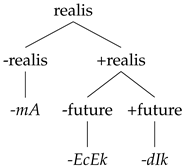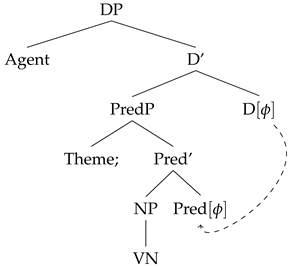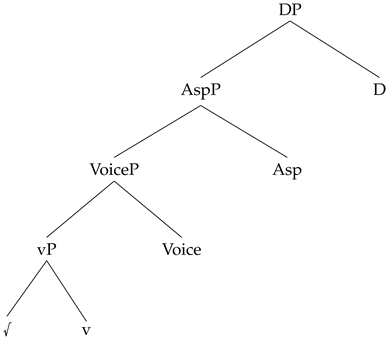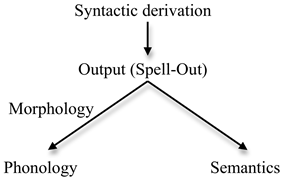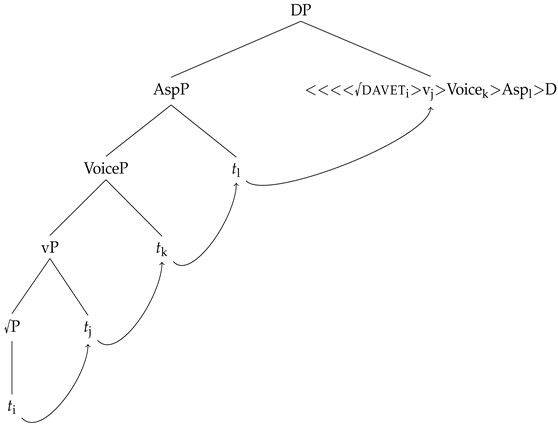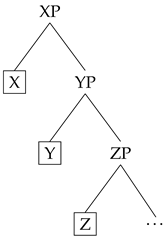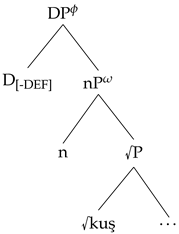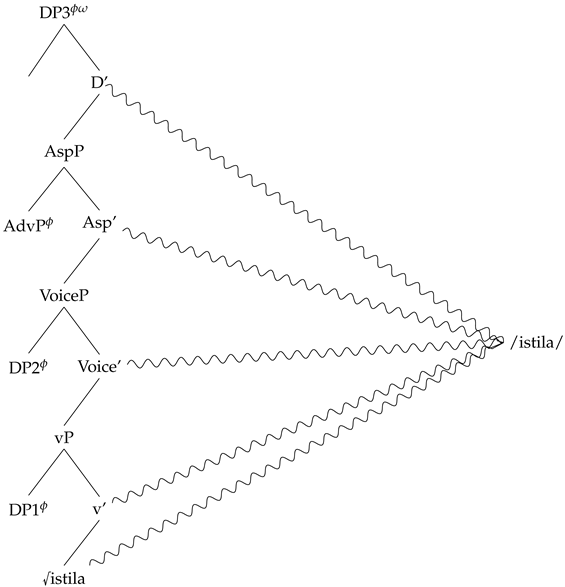Lexical Borrowing Targets Spans
Abstract
1. Introduction
- (1)
- The frequent murder of the judicial officials
- (2)
müdür-ün veli-ler-i tören-e davet-i principal-GEN parent-PL-ACC ceremony-DAT invitation-3.POSS ‘the principal’s invitation of / inviting the parents to the ceremony’ - (3)
birlik-ler-in bölge-yi işgal-i troop-PL-GEN territory-ACC occupation-3.POSS ‘the troops’ occupation of / occupying the territory ’
- (4)
*müdür-ün veli-ler-i tören-e çağrı-sı principal-GEN parent-PL-ACC ceremony-DAT call-3.POSS Intended: ‘the principal’s invitation of/inviting the parents to the ceremony’ - (5)
müdür-ün veli-ler-i tören-e çağır-ma-sı principal-GEN parent-PL-ACC ceremony-DAT call-NOM-3.POSS ‘the principal’s inviting the parents to the ceremony’
- (6)
*müdür-ün duvar-lar-ı boya-sı principal-GEN wall-PL-ACC paint-3.POSS Intended: ‘the principal’s painting the walls’ - (7)
müdür-ün duvar-lar-ı boya-ma-sı principal-GEN wall-PL-ACC paint-NOM-3.POSS ‘the principal’s painting the walls’
2. Underived Complex Event Nominals in Turkish
- (8)
banka-nın para-yı iade-si bank-GEN money-ACC return-3.POSS “the bank’s compensation of/compensating the money” - (9)
uzaylı-lar-ın dünya-yı istila-sı alien-PL-GEN earth-ACC invasion-3.POSS “aliens’ invasion of/invading the earth” - (10)
Mehmet’in İstanbul’u feth-i Mehmet-GEN Istanbul-ACC conquest-3.POSS “Mehmet’s conquest of/conquering Istanbul” - (11)
insan-oğlu-nun doğa-yı katl-i human-son-GEN nature-ACC murder-3.POSS “humanity’s murder of/killing the nature”
2.1. UCENs Differ from Derived Nominals
- (12)
düşman-ın şehr-i hunhar-*(ca) istila-sı enemy-GEN city-ACC cruel(ly) invasion-3.POSS “the enemy’s cruelly invading the city” - (13)
doktor-un hasta-yı *dikkatli/dikkatle muayene-si doctor-GEN patient-ACC careful/carefully examination-3.POSS “the doctor’s carefully examining the patient” (adapted from Sezer 1991, pp. 43–54) - (14)
doktor-un hasta-yı *dikkatli/dikkatle gözlemle-me-si doctor-GEN patient-ACC careful/carefully observe-NOM-3.POSS “the doctor’s carefully observing the patient”
- (15)
Avrupa Parlamentosun-dan gönülsüz /*gönülsüzce çağrı European Parliament-DAT halfhearted /halfheartedly call “a halfhearted call from the European Parliament” - (16)
insan-lar-dan cömert /*cömertçe bağış-lar people-DAT generous /generously donation-PL “generous donations from people” - (17)
uzman-lar-ın önem-li/*önem-le uyarı-sı expert-PL-GEN important/importantly warning-3.POSS “experts’ important warning/the important warning of the experts”
- (18)
Üç uzaylı iki-şer gezegen-i istila et-ti. three space two-each planet-ACC invasion do-PST “Three aliens each invaded two planets.” - (19)
Üç uzaylı-nın iki-şer gezegen-i istila-sı three space-GEN two-each planet-ACC invasion-3.POSS “Three aliens’ each invading two planets”
- (20)
çalışan-lar-ın iki-şer şey-i taleb-i /tarif-i /tercüme-si /tasvir-i /tasvib-i employer-PL-GEN two-each thing-ACC request /description /translation /portrayal /approval-3.POSS “the employees’ requiring/describing/translating/portraying/approving two things each” - (21)
devlet-ler-in bir-er bölge-yi işgal-i /istila-sı /ihlak-ı /feth-i /iade-si country-PL-GEN one-each territory-ACC occupation /invasion /acquisition /conquest /return-3.POSS “the countries’ occupying/invading/acquiring/conquering/returning one territory each”
- (22)
öğrenci-ler-in iki-şer şey-e ?/*sevgi-si /?/*çözüm-ü /eleştiri-si /etki-si student-PL-GEN two-each thing-DAT love-3.POSS solution-3.POSS criticism-3.POSS influence-3.POSS “The students’ love towards /solution for /criticism of /influence on two things each” - (23)
öğrenci-ler-in iki-şer şey-i sev-me-si /çöz-me-si /eleştir-me-si /etkile-me-si student-PL-GEN two-each thing-ACC love-NOM-3.POSS solve-NOM-3.POSS criticize-NOM-3.POSS influence-NOM-3.POSS “The students’ loving /solving /criticizing /influencing two things each”
- (24)
Aktivist-ler-in halk-a çağrı-sı iki ay sür-dü. activist-PL-GEN people-DAT call-3.POSS two month last-PST “The activists’ call to the people lasted two months.” - (25)
Düşman-ın bölge-yi işgal-i on yıl sür-dü. enemy-GEN territory-ACC occupation-3.POSS ten year last-PST “The enemy’s occupation of the territory lasted ten years.” - (26)
*activist-ler-in halk-a iki ay-dır çağrı-sı activist-PL-GEN people-DAT two month-ADV call-3.POSS Intended: “The activists’ call to the people for two months.” - (27)
düşman-ın on yıl-dır bölge-yi işgal-i enemy-GEN ten year-ADV territory occupation-3.POSS “the enemy’s occupation of the territory for ten years”
- (28)
general-ler-in Batı-yı kızdır-mak için bölge-yi işgal-i general-PL-GEN West-ACC annoy-INF for territory-ACC occupation-3.POSS “the generals’ occupation of the territory in order to annoy the West”
- (29)
*gazeteci-nin bakan-ı kızdır-mak için hükûmet-e eleştiri-si journalist-GEN minister-ACC annoy-INF for government-DAT criticism-3.POSS Intended: “the journalist’s criticism of the government in order to annoy the minister’ - (30)
gazeteci-nin bakan-ı kızdır-mak için hükûmet-i eleştir-me-si journalist-GEN minister-ACC annoy-inf for government-ACC criticize-NOM-3.POSS “the journalist’s criticizing the government in order to annoy the minister’
- (31)
birlik-ler-in bölge-yi *hevesli/hevesle işgal-i troop-PL-GEN territory-ACC enthusiastic/enthusiastically occupation-3.POSS “the troops’ occupying the territory enthusiastically”
2.2. UCENs Differ from Gerundive Nominals
2.2.1. UCENs Are Not TP Nominalizations
- (32)
birlik-ler-in bölge-yi işgal-i troop-PL-GEN territory-ACC occupation-3.POSS “the troops’ occupation of the territory” - (33)
birlik-ler-in bölge-yi al-ma-sı troop-PL-GEN territory-ACC take-NOM-3.POSS “the troops’ seizing the territory” - (34)
birlik-ler-in bölge-yi al-dığ-ı troop-PL-GEN territory-ACC seize-NOM-3.POSS “that the troops seize/have seized the territory” - (35)
birlik-ler-in bölge-yi al-acağ-ı troop-PL-GEN territory-ACC seize-NOM-3.POSS “that the troops will/would seize the territory”
- (36)
- (37)
Hasan [uşağ-ın oda-yı temizle-diğ-in]-i söyle-di. Hasan servant-GEN room-ACC clean-NOM-3.POSS-ACC tell-PST “Hasan said that the servant cleaned the room.” - (38)
Hasan [uşağ-ın oda-yı temizle-me-sin]-i söyle-di. Hasan servant-GEN room-ACC clean-NOM-3.POSS-ACC tell-PST “Hasan said that the servant should clean the room.”
- (39)
*General birlik-ler-in bölge-yi işgal-in-i söyle-di /belirt-ti /iddia et-ti /ifade etti general troop-PL-GEN territory-ACC occupation-3.POSS-ACC say-PST /state-PST /claim do-PST /indication do-PST Intended: “The general said/stated/claimed/indicated that the troops (should) occupy the territory.” - (40)
*General birlik-ler-in bölge-yi işgal-in-i iste-di /san-dı /dile-di /um-du general troop-PL-GEN territory-ACC occupation-3.POSS-ACC want-PST /think-PST /wish-PST /hope-PST Intended: “The general wanted/thought/wished/hoped that the troops (should) occupy the territory.”
2.2.2. UCENs Cannot form Synthetic Compounds
- (41)
- [truck [driver]]
- (42)
- [[truck drive]r]
- (43)
kamyon sür-ücü(-sü) truck drive-er-3.POSS “truck driver” - (44)
akşam / uzun mesafe sür-ücü-*(sü) evening / long distance drive-er-3.POSS “evening / long distance driver”
- (45)
ruh çağır-ma spirit call-NOM “evocation” - (46)
görüntü onar-ma image repair-NOM “image restoration” - (47)
fidye iste-me ransom want-NOM “ransom demand”
- (48)
ruh davet-*(i) spirit invite-3.POSS intended: “evocation” - (49)
görüntü tamir-*(i) image repair-3.POSS Intended: “image restoration” - (50)
fidye taleb-*(i) ransom demand-3.POSS Intended: “ransom demand”
- (51)
- the lifting of the package
- (52)
- package lifting
- (53)
- [DP [nExtP [nP ( [vExtP ) [vP [√ROOT]]]]]] FULL NOMINALS
- (54)
- [DP [vExtP [vP [√ROOT]]]] DEFECTIVE NOMINALS
2.3. Summary
3. Previous Accounts
3.1. Sezer (1991)
- (55)
düşman-ın şehr-i hunhar-*(ca) istila-sı enemy-GEN city-DAT cruel(ly) invasion-3.POSS “the enemy’s cruelly invading the city” - (56)
doktor-un hasta-yı *dikkatli/dikkatle muayene-si doctor-GEN patient-DAT careful/carefully examination-3.POSS “the doctor’s carefully examining the patient” (adapted from Sezer 1991, pp. 43–54) - (57)
- [[istila]N et]V + Acc → [[istila]N ]V + Acc(adapted from Sezer 1991, p. 54)
- (58)
Sekreter yazı-yı daktilo et-ti secretary text-ACC type-writer do-PST “The secretary typed the text.” - (59)
*sekreter-in yazı-yı daktilo-su secretary-GEN text-ACC type-writer-3.POSS Intended: “the secretary’s typing of the text”
- (60)
Ali Osman’ı kal-ma-ya razı et-ti Ali Osman-ACC stay-NOM-DAT content do-PST “Ali convinced Osman to stay.” - (61)
*Ali’nin Osman’ı kalma-ya razı-sı Ali-GEN Osman-ACC stay-NOM-DAT content-3.POSS Intended: “Ali’s convincing Osman to stay”
- (62)
(Bu) fare-ler-in köy-ümüz-ü (bu) durmadan (bu) istila-sı this mouse-PL-GEN village-1PL.POSS-ACC this constantly this invasion-3.POSS “This constant invasion of our village by mice.” - (63)
(*Bu) fare-ler köy-ümüz-ü (*bu) durmadan (*bu) istila et-ti this mouse-PL village-1PL.POSS-ACC this constantly this invasion do-PST
- (64)
- *[vP [DP…]
- (65)
- *[this material]-ize
- (66)
Tamirci dolab-ı duvar-a monte / *montaj etti repairman cupboard-ACC wall-DAT install / installation do-PST “The repairman installed the cupboard on the wall.” - (67)
tamirci-nin dolab-ı duvar-a *monte-si / montaj-ı repairman-GEN cupboard-ACC wall-DAT install-3.POSS / installation-3.POSS “The repairman installed the cupboard on the wall.” - (68)
Belediye kilise-yi restore / *restorasyon et-ti municipality church-ACC restore do-PST “The municipality restored the church.” - (69)
belediye-nin kilise-yi *restore-si / restorasyon-u municipality-GEN church-ACC restore-3.POSS / restoration3.POSS “the municipality’s restoration of the church”
3.2. Keskin (2009)
- (70)
- Keskin’s Jump-starting hypothesis (2009):
3.3. Solak (2022)
- (71)
iş-i tamamla-mak work-ACC complete-INF “to complete the work” - (72)
iş-i ikmal work-ACC completing “to complete the work”
- (73)
Hasani PROi öğrenci-ler-i parti-ye çağır-mak iste-di Hasan PRO student-PL-ACC party-DAT call-INF want-PST “Hasan wanted to invite the students to the party.” - (74)
Hasani PROi öğrenci-ler-i parti-ye çağır-mağ-a çalış-tı /karar ver-di /söz ver-di Hasan PRO student-PL-ACC party-DAT call-INF-DAT try-PST /decision give-PST /word give-PST “Hasan tried/decided/promised to invite the students to the party.”
- (75)
*Hasan öğrenci-ler-i parti-ye davet iste-di Hasan student-PL-ACC party-DAT call-INF want-PST Intended: “Hasan wanted to invite the students to the party.” - (76)
*Hasan öğrenci-ler-i parti-ye davet-e çalış-tı /karar ver-di /söz ver-di Hasan student-PL-ACC party-DAT invitation-DAT try-PST /decision give-PST /word give-PST Intended: “Hasan tried/decided/promised to invite the students to the party.”
3.4. Summary
4. Proposal
- (77)
- (78)
- Architecture of grammar in DM (Bobaljik 2017)
4.1. UCENs as Complex Heads
- (79)
- (80)
- davet+∅+∅+∅+∅
4.2. UCENs as Fused Heads
4.3. UCENs as Spans
- (81)
- (82)
/bi ku.şák/ a belt “a belt"
- (83)
- Syntax
| (84) | L-Match | (85) | Insert |
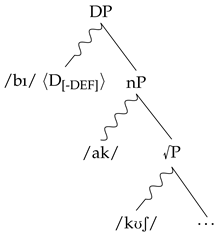 | 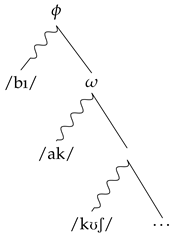 |
- (86)
Birlik-ler-in bölge-yi hunharca kuşatma-sı bekle-n-m-iyor-du troop-PL-GEN territory-ACC violently occupying-3.POSS expect-PASS-NEG-PROG-PST “The troops’ occupying the territory violently was not expected.”
| (87) |  | (88) |  | (88) |  |
- (90)
Birlik-ler-in bölge-yi istila-sı bekle-n-m-iyor-du troop-PL-GEN territory-ACC occupying-3.POSS expect-PASS-NEG-PROG-PST “The troops’ occupying the territory was not expected.”
- (91)
5. Conclusions
Funding
Acknowledgments
Conflicts of Interest
Abbreviations
| 3 | third person |
| ACC | accusative |
| ADV | adverb |
| DAT | dative |
| DM | Distributed Morphology |
| GEN | genitive |
| INF | infinitive |
| LVC | light verb construction |
| NEG | negative |
| NOM | nominalizer |
| PASS | passive |
| PL | plural |
| POSS | possessive |
| PROG | progressive |
| PST | past |
| TAM | tense, aspect and modality |
| UCEN | underived complex event nominal |
| 1 | It is customary in Turkish linguistics to capitalize the vowel in morphemes that are subject to vowel harmony. For example, in this particular case, mA can be surface as -me or -ma depending on whether the vowel of the preceding syllable is back or front. Some other morphemes are also subject to roundness harmony and thus have four surface forms rather than two. For example, the accusative -I may surface as -ü, -i, -u or -ı, the latter being a back, high, unround vowel. Some linguists also capitalize consonants that assimilate in voicing. The causative -DIr thus has eight surface forms: -dür, -dir, -dur, -dır, -tür, -tir, -tur, -tır. | ||||||||||||||||||
| 2 | I would like to thank Greg Key for pointing out that there is also a small set of accusative-assigning borrowings of Arabic origin which are used in modern Turkish only in certain archaic forms, such as müteakip ‘successive, following’ and haiz ‘possessing’ as exemplified below. As he points out, these forms are also acceptable with dative-marked objects (G. Key, personal communication, 6 September 2021). These Arabic forms do not fall into the category of UCENs as defined in this paper, which categorically assign accusative case, and I will therefore not include them in the argumentation and discussion in the rest of this paper.
| ||||||||||||||||||
| 3 | An anonymous reviewer states that the sentence would be acceptable with the verb emret- ‘to order.’ I agree with the judgement but I do not know why it is the case. Perhaps emret- is not an attitude verb after all. | ||||||||||||||||||
| 4 | There is at least one exception, an UCEN, which is equally well-formed when selected by the light verb et- or the elsewhere verbalizer -lA: ispat et- ∼ ispatla- ‘prove’ both of which are transitive in Turkish. | ||||||||||||||||||
| 5 | Akkuş (2015) proposes a lexical blocking analysis of the French alternation presented here, where the presence of certain features, e.g. +predicative blocks the insertion of verbal elements, such as restore. Key and Tat (2014) propose that competition occurs only at the syntactic terminals during vocabulary insertion, e.g. -e and -aj compete for insertion in the presence of the root √MONT. If montaj and monte are categorially different, such that the former is a DP-nominalization and the latter is not, no competition has to take place between the two affixes. | ||||||||||||||||||
| 6 | Öztürk (2005) deserves a mention here, who observes that “[c]ertain light verb constructions in Turkish are formed with a non-Turkic noun root and the light verb et- ‘do”’ (p. 55) as we have seen in a number of examples in previous sections. She claims that these light verb constructions are true [NP V] complex predicates, whereby a predicative NP, such as redd “rejecting” (similar to the above-mentioned examples such as istila “invading,” muayane “examining” or monte “installing) is denominalized by the light verb et-. The fact that these NPs can have an argument structure even in the absence of a light verb is given as evidence that they are indeed predicative. While her observations are indisputable, they do not tell us anything as to why only NPs of non-Turkic origins form complex predicates or why they are predicative despite their simple makeup in the first place. | ||||||||||||||||||
| 7 | Productivity is a questionable property here. While it is true that Turkish cannot coin new UCENs within its native lexical inventory, and it is no longer borrowing new words from Arabic as it did in the past, they can be considered productive since they are in their source language in the first place. | ||||||||||||||||||
| 8 | Keskin (2009) relates his proposal to Burzio’s Generalization (Burzio 1986), the Visibility Condition (Chomsky 1986) and the requirement of agreement for licensing subjects in Turkish (Kornfilt 2005), and claims that UCENs must have subjects. Consider (i), which is perfectly acceptable in Turkish. However, one can argue, these phrases have implied agents and must therefore have a PRO subject (see Borer 2020; Bruening 2013; Roeper 1987; Sichel 2009), which would support Keskin’s claims.
| ||||||||||||||||||
| 9 | The two different sets of nouns in Spanish seem to be lexically-determined by chance, not following any grammatical generalizations (A. Fábregas, personal communication, 1 September 2021). | ||||||||||||||||||
| 10 | There are a number of markers that can lexicalize v and Voice heads (or a combination of two) in Turkish. How they all compete for exponence is beyond the scope of this study. However, it should be noted that lexically specified vocabulary items must compete at L-Match while phonologically conditioned allomorphy must be further subject to conditions that apply at Insert. | ||||||||||||||||||
| 11 | However, see Kabak and Vogel (2001) who show that new harmony domains may begin within the same phonological word due to the presence of certain suffixes or clitics. | ||||||||||||||||||
| 12 | A comparable model for the architecture of grammar is proposed by Fábregas and Putnam (2020). In their model, abstract syntactic structure is “packaged” by an interface level, Structure, before transfer to PF and LF can take place. Unlike Spanning though, Structure does not replace syntactic terminals. Instead, it provides restrictions as to what kind of syntactic categories are allowed in adjacent positions (=selectional restrictions) as well as phonological values. | ||||||||||||||||||
References
- Akkuş, Faruk. 2015. Light verb constructions in Turkish: A case for DP predication and blocking. In Proceedings of the 9th Workshop on Altaic Formal Linguistics (MITWPL 76). Edited by Andrew Joseph and Esra Predolac. Cambridge: MIT Press, pp. 133–45. [Google Scholar]
- Alexiadou, Artemis. 2001. Functional Structure in Nominals. Amsterdam: John Benjamins. [Google Scholar]
- Alexiadou, Artemis. 2008. On the Role of Syntactic Locality in Morphological Processes: The Case of (Greek) Derived Nominals. Frankfurt: Universitätsbibliothek Johann Christian Senckenberg. [Google Scholar]
- Alexiadou, Artemis. 2017. Nominalization Structures across Languages. London: Queen Mary University of London. [Google Scholar]
- Alexiadou, Artemis, and Jane Grimshaw. 2008. Verbs, nouns and affixation. Working Papers of the SFB 732 Incremental Specification in Context 1: 1–16. [Google Scholar]
- Alexiadou, Artemis, and Terje Lohndal. 2018. Units of language mixing: A cross-linguistic perspective. Frontiers in Psychology 9: 1719. [Google Scholar] [CrossRef] [PubMed]
- Arregi, Karlos, and Andrew Nevins. 2012. Morphotactics: Basque Auxiliaries and the Structure of Spellout. Berlin: Springer Science & Business Media, vol. 86. [Google Scholar]
- Baker, Mark. 2000. Category asymmetries in derivational morphology. In Morphology 2000. Edited by Sabrina Bendjaballah, Maria D. Voeikova, Oskar E. Pfeiffer and Wolfgang U. Dressler. Amsterdam: John Benjamins, pp. 17–35. [Google Scholar]
- Baker, Mark. 2003. Lexical Categories: Nouns, Verbs, and Adjectives. Cambridge: Cambridge University Press. [Google Scholar]
- Bobaljik, Jonathan David. 2017. Distributed Morphology. Oxford Research Encyclopedias (Online). Available online: https://oxfordre.com/linguistics/view/10.1093/acrefore/9780199384655.001.0001/acrefore-9780199384655-e-131 (accessed on 16 October 2022). [CrossRef]
- Borer, Hagit. 1999. The form, the forming, and the formation of nominals. Paper presented at 2nd Mediterranean Morphology Meeting, ZLija, Malta, September 10–12. [Google Scholar]
- Borer, Hagit. 2003. Exo-skeletal vs. endo-skeletal explanations: Syntactic projections and the lexicon. The Nature of Explanation in Linguistic Theory 31: 67. [Google Scholar]
- Borer, Hagit. 2009a. Categorizing Roots. In Talk Presented at Roots. Stuttgart: Universität Stuttgart, June 10–12. [Google Scholar]
- Borer, Hagit. 2009b. Roots and categories. In Talk Presented at the 19th Colloquium on Generative Grammar. Vitoria-Gasteiz: University of the Basque Country. Available online: http://www-rcf.usc.edu/~borer/rootscategories.pdf (accessed on 16 October 2022).
- Borer, Hagit. 2012. In the event of a nominal. In The Theta System: Argument Structure at the Interface. Edited by by Martin Everaert, Marijana Marelj and Tal Siloni. Oxford: Oxford University Press, pp. 103–49. [Google Scholar]
- Borer, Hagit. 2020. Nominalizing verbal passive: Pros and cons. In Nominalization: 50 Years on from Chomsky’s Remarks. Edited by Artemis Alexiadou and Hagit Borer. Oxford: Oxford University Press, pp. 111–37. [Google Scholar]
- Bruening, Benjamin. 2013. By-phrases in passives and nominals. Syntax 16: 1–41. [Google Scholar] [CrossRef]
- Burzio, Luigi. 1986. Italian Syntax: A Government-Binding Approach. Berlin: Springer Science & Business Media, vol. 1. [Google Scholar]
- Bye, Patrik, and Peter Svenonius. 2012. Non-concatenative morphology as epiphenomenon. In The Morphology and Phonology of Exponence. Edited by Jochen Trommer. Oxford: Oxford University Press, pp. 427–95. [Google Scholar]
- Chomsky, Noam. 1970. Remarks no nominalization. In Readings in English Transformational Grammar. Waltham: Ginn and Co. [Google Scholar]
- Chomksy, Noam. 1986. Knowledge of Language: Its Nature, Origin, and Use. Westport: Greenwood Publishing Group. [Google Scholar]
- Chomsky, Noam. 2001. Derivation by phase. In Ken Hale: A Life in Language. Edited by Michael Kenstowicz. Cambridge: MIT Press. [Google Scholar]
- Chomsky, Noam. 2008. On phases. Current Studies in Linguistics Series 45: 133. [Google Scholar]
- Dede, Muserref Agan. 1978. A Syntactic and Semantic Analysis of Turkish Nominal Compounds. Ph.D. thesis, University of Michigan, Ann Arbor, MI, USA. [Google Scholar]
- Fábregas, Antonio, and Michael T. Putnam. 2020. Passives and Middles in Mainland Scandinavian. Berlin: De Gruyter Mouton. [Google Scholar]
- Fábregas, Antonio. 2014. Argument structure and morphologically underived nouns in Spanish and English. Lingua 141: 97–120. [Google Scholar] [CrossRef]
- George, Leland, and Jaklin Kornfilt. 1981. Finiteness and boundedness in Turkish. Binding and Filtering 105: 127. [Google Scholar]
- Göksel, Aslı. 2009. Compounds in Turkish. Lingue e linguaggio 8: 213–36. [Google Scholar]
- Göksel, Aslı, and Belma Haznedar. 2007. Remarks on compounding in Turkish. In MorboComp Project. Bologna: University of Bologna. [Google Scholar]
- Grimshaw, Jane. 1990. Argument Structure. Cambridge: MIT Press. [Google Scholar]
- Grimshaw, Jane. 2005. Extended projection. In Words and Structure. Edited by Jane Grimshaw. Stanford: CSLI, pp. 1–74. [Google Scholar]
- Halle, Morris, and Alec Marantz. 1993. Distributed morphology and the pieces of inflection. In The View From Building 20. Edited by Kenneth Grimshaw and Samuel Jay Keyser. Cambridge: MIT Press, pp. 111–176. [Google Scholar]
- Halle, Morris, and Alec Marantz. 1994. Some key features of distributed morphology. MIT Working Papers in Linguistics 21: 275–88. [Google Scholar]
- Harizanov, Boris, and Vera Gribanova. 2019. Whither head movement? Natural Language & Linguistic Theory 37: 461–22. [Google Scholar]
- Harley, Heidi. 2009. The morphology of nominalizations and the syntax of vp. In Quantification, Definiteness and Nominalization. Oxford: Oxford University Press, pp. 320–42. [Google Scholar]
- Harley, Heidi, and Rolf Noyer. 1999. Distributed morphology. In The Second Glot International State-of-the-Article Book. Berlin: De Gruyter Mouton, pp. 463–96. [Google Scholar]
- Iordăchioaia, Gianina. 2020. D and N are different nominalizers. Glossa: A Journal of General Linguistics 5: 53. [Google Scholar] [CrossRef]
- Kabak, Barış, and Irene Vogel. 2001. The phonological word and stress assignment in Turkish. Phonology 18: 315–60. [Google Scholar] [CrossRef]
- Keskin, Cem. 2009. Subject Agreement-Dependency of Accusative Case in Turkish or Jump-Starting Grammatical Machinery. Warsaw: LOT. [Google Scholar]
- Key, Greg, and Deniz Tat. 2014. On (non-)alternating complex predicates in Turkish. Paper presented at 10th Workshop on Altaic Formal Linguistics (WAFL10), Cambridge, MA, USA, May 2–4. [Google Scholar]
- Kharytonava, Volha. 2011. Noms Composés en Turc et Morphème-(s) I. Ph.D. thesis, University of Western Ontario, London, ON, Canada. [Google Scholar]
- Kornfilt, Jaklin. 1984. Case Marking, Agreement and Empty Catagories in Turkish. Ph.D. thesis, Harvard University, Cambridge, MA, USA. [Google Scholar]
- Kornfilt, Jaklin. 2003. Scrambling, subscrambling, and case in Turkish. In Word Order and Scrambling. Edited by Simin Karimi. Oxford: Blackwell, pp. 125–55. [Google Scholar]
- Kornfilt, Jaklin, and John Whitman. 2011. Afterword: Nominalizations in syntactic theory. Lingua 121: 1297–313. [Google Scholar] [CrossRef]
- Kornfilt, Jaklin. 2005. Agreement: The (unique and local) syntactic and morphological licenser of subject Case. In Studies on agreement. Edited by João Costa and Figueiredo Silva Maria Cristina. Amsterdam: John Benjamins, pp. 141–172. [Google Scholar]
- Kunduracı, Aysun. 2013. Turkish Noun-Noun Compounds: A Process-Based Paradigmatic Account. Ph.D. thesis, University of Calgary, Calgary, AB, Canada. [Google Scholar]
- Lewis, Geoffrey. 1967. Turkish Grammar. Oxford: Oxford University Press. [Google Scholar]
- Lewis, Geoffrey. 1999. The Turkish Language Reform: A Catastrophic Success: A Catastrophic Success. Oxford: Oxford University Press. [Google Scholar]
- Lieber, Rochelle. 2016. English Nouns: The Ecology of Nominalization. Cambridge: Cambridge University Press, vol. 150. [Google Scholar]
- López, Luis. 2020. Toward an Integrated Model of Bilingual Grammar. Cambridge: Cambridge University Press. [Google Scholar]
- Nakipoğlu, Mine, and Aslı Üntak. 2008. A complete verb lexicon of Turkish based on morphemic analysis. Turkic Languages 12: 221–80. [Google Scholar]
- Newmeyer, Frederick. 2009. Current challenges to the lexicalist hypothesis. In Time and Again: Theoretical Perspectives on Formal Linguistics. Amsterdam: John Benjamins, pp. 91–17. [Google Scholar]
- Öztürk, Balkız. 2005. Case, Referentiality and Phrase Structure. Amsterdam: John Benjamins Publishing Company. [Google Scholar]
- Roeper, Thomas. 1987. Implicit arguments and the head-complement relation. Linguistic Inquiry 18: 267–310. [Google Scholar]
- Ryding, Karin C. 2005. A Reference Grammar of Modern Standard Arabic. Cambridge: Cambridge University Press. [Google Scholar]
- Safir, Ken, and Tim Stowell. 1987. Binominal each. In North East Linguistics Society. Edited by James Blevins and Juli Carter. Amherst: GLSA Publications, vol. 18, pp. 246–50. [Google Scholar]
- Scalise, Sergio, and Antonietta Bisetto. 2009. The classification of compounds. In The Oxford Handbook of Compounding. Edited by Rochelle Lieber and Pavol Štekauer. Oxford: Oxford University Press, pp. 34–54. [Google Scholar]
- Sezer, Fehmi Engin. 1991. Issues in Turkish Syntax. Cambridge: Harvard University. [Google Scholar]
- Sichel, Ivy. 2009. New evidence for the structural realization of the implicit external argument in nominalizations. Linguistic Inquiry 40: 712–23. [Google Scholar] [CrossRef]
- Siddiqi, Daniel. 2009. Syntax within the Word: Economy, Allomorphy and Argument Selection in Distributed Morphology. Amsterdam: John Benjamins. [Google Scholar]
- Smith, Carlota S. 1972. On causative verbs and derived nominals in English. Linguistic Inquiry 3: 136–38. [Google Scholar]
- Solak, Ercan. 2022. Accusative licensing of nouns in Turkish. Paper presented at Workshop on Turkic and Languages in Contact with Turkic, Virtually, February 18–19, vol. 6, p. 5052. [Google Scholar]
- Svenonius, Peter. 2012. Spanning. Tromsø: University of Tromsø. Available online: https://ling.auf.net/lingbuzz/001501 (accessed on 16 October 2022).
- Svenonius, Peter. 2016. Spans and words. In Morphological Metatheory. Edited by Daniel Siddiqi and Heidi Harley. Amsterdam: John Benjamins Amsterdam, vol. 229, pp. 201–22. [Google Scholar]
- Svenonius, Peter. 2018. Delimiting the Syntactic Word. Paper presented at Linguistics at Santa Cruz March 10, UCSC; Available online: https://blogg.uit.no/psv000/wp-content/uploads/sites/55/2018/04/syntacticword.pdf (accessed on 16 October 2022).
- Tat, Deniz. 2013. Word Syntax of Nominal Compounds: Internal and Aphasiological Evidence from Turkish. Tucson: The University of Arizona. [Google Scholar]
- Tat, Deniz, and Jaklin Kornfilt. 2018. Haplology within m-words and p-words: Revisiting the stuttering prohibition in Turkish. IULC Working Papers 18: 1–28. [Google Scholar]
- Van Schaaik, Gerjan. 2002. The noun in Turkish: Its Argument Structure and the Compounding Straitjacket. Wiesbaden: Otto Harrassowitz Verlag, vol. 49. [Google Scholar]
- Yükseker, Hitay. 1987. Turkish nominal compounds. Toronto Working Papers in Linguistics 7: 83–102. [Google Scholar]
- Zucchi, Alessandro. 1989. The Language of Propositions and Events: Issues in the Syntax and the Semantics of Nominalization. Amherst: University of Massachusetts Amherst. [Google Scholar]
| Foreign Stem | Foreign Stem | Turkic Stem | Turkic Stem | English |
|---|---|---|---|---|
| w/light verb | w/-la | w/light verb | w/-la | |
| tasvip et- | *tasviple | *onay et- | onay-la | ‘approve’ |
| tasvir et- | *tasvirle | *betim et- | betim-le | ‘describe |
| tanzim et- | *tanzimle | *düzen et- | düzen-le | ‘arrange, organize’ |
| tarif et- | *tarifle | *tanım et- | tanım-la | ‘define’ |
| tahlil et- | *tahlille- | *çözüm et- | çözümle- | ‘analyze’ |
| hayal et- | *hayalle | *düş et- | düşle- | ‘dream, imagine’ |
| ifade et- | *ifadele | *açık et- | açıkla | ‘state, express’ |
Publisher’s Note: MDPI stays neutral with regard to jurisdictional claims in published maps and institutional affiliations. |
© 2022 by the author. Licensee MDPI, Basel, Switzerland. This article is an open access article distributed under the terms and conditions of the Creative Commons Attribution (CC BY) license (https://creativecommons.org/licenses/by/4.0/).
Share and Cite
Tat, D. Lexical Borrowing Targets Spans. Languages 2022, 7, 289. https://doi.org/10.3390/languages7040289
Tat D. Lexical Borrowing Targets Spans. Languages. 2022; 7(4):289. https://doi.org/10.3390/languages7040289
Chicago/Turabian StyleTat, Deniz. 2022. "Lexical Borrowing Targets Spans" Languages 7, no. 4: 289. https://doi.org/10.3390/languages7040289
APA StyleTat, D. (2022). Lexical Borrowing Targets Spans. Languages, 7(4), 289. https://doi.org/10.3390/languages7040289





